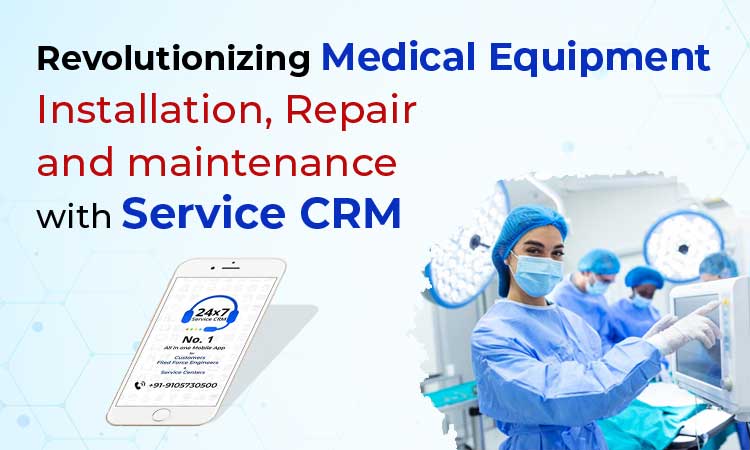Revolutionizing Medical Equipment Installation, Repair and maintenance with Service CRM

Technology innovations have been at the forefront of the healthcare industry’s dramatic transition in recent years, with a focus on bettering patient care and making the most of healthcare facilities. The development of new methods for managing medical equipment is an essential part of this change with Medical Equipment Management Software 2024.
The proper diagnosis and treatment of patients depends on several pieces of medical equipment.
The Problem with Conventional Methods of Managing Medical Equipment
Managing medical supplies has always been a laborious and time-consuming process. Equipment failure, compliance with regulations, inventory management, and tracking assets are familiar sources of stress for healthcare practitioners. Patient safety, operational efficiency, and maintenance expenses might all suffer as a result of encountering these obstacles.
Therefore, Healthcare institutions often confront the following difficulties when attempting to manage their medical equipment:
Hand-Derived Methods:
Paper-based, time-consuming manual methods are still widely used by healthcare facilities. There’s a risk of inefficiency, lost records, and erroneous data as a result.
Breakdowns in the Machine:
Repairing or replacing broken equipment is expensive and might impede patient care. Lack of regular preventative maintenance is a common problem.
Observance of the Law:
When it comes to the upkeep and security of medical devices, healthcare institutions must adhere to stringent rules and regulations. It can be challenging to enforce compliance.
Monitoring Assets:
It is crucial to know the real-time location and status of medical equipment. Applying the old practices would be a huge hassle.
The Rise of Software for Managing Medical Equipment
In light of these difficulties, medical institutions can benefit significantly from Medical Equipment Management Software 2024 (MEMS). MEMS is an all-encompassing software solution that helps medical facilities stay in line with regulations throughout equipment setup, servicing, and upkeep.
Features Essential to Effective Medical Device Management:
Therefore, Medical equipment management may benefit significantly from MEMS’s large variety of characteristics. Some of the more notable factors are:
Monitoring Assets:
With Medical Equipment Management Software, medical facilities may store all of their devices in one place, and their status and whereabouts can be observed in real time. This reduces the possibility of lost tools and guarantees their optimal use.
Upkeep Precautions:
Schedule and automate preventative maintenance chores using this software to minimize equipment failures and maximize the useful life of medical facility machinery.
Observance of the Law:
The Medical Device Service Management Software (MEMS) was develop to aid hospitals in meeting the requirements of the Joint Commission and the Food and Drug Administration (FDA).
Controlling Stock:
With better inventory management, hospitals and clinics may avoid running out of vital tools or having too much of a surplus.
Managing Service Requests:
With Medical Device service management software, hospitals and other medical facilities may quickly establish and monitor work orders for fixing broken pieces of equipment.
Tracking Expenses:
Healthcare institutions may use the program to track the money they spend on repairs and upkeep of their equipment, which can lead to more efficient budgeting and cost-cutting.
Analytics of Data:
The information gathered by MEMS on the condition and use of medical equipment is handy for optimizing resource allocation and providing better treatment to patients.
Advantages of Medical Equipment Management Systems
Healthcare facilities and their patients may gain a lot from using Medical equipment service scheduling software. However, Some of the main benefits are as follows:
- MEMS improves the operational efficiency of healthcare institutions because of the streamlined administration of medical equipment.
- Medical centers may save money on costly repairs and replacements by instituting automated preventative maintenance programs.
- Compliance with Healthcare Regulations and Standards: Medical equipment service scheduling software makes it easier to meet these requirements, which lessens the likelihood of fines and other legal trouble.
- Valuable Insights The program offers useful insights into the performance and utilization of equipment, allowing for data-driven decision-making around resource allocation and equipment replacement.
- Effective inventory management eliminates both equipment shortages and surplus, guaranteeing that medical professionals will always have access to the tools they need.
Therefore, MEMS makes it easy for hospital managers to monitor and enhance equipment management by generating thorough information on equipment maintenance, repair history, and compliance.
What Makes Service CRM Reliable?
Service CRM is an all-inclusive system intended to improve and standardize the service of medical devices and Healthcare Maintenance AMC Management Software. It coordinates and streamlines all efforts connected to maintaining the facility’s machinery. However, Here are some of the ways in which Service CRM is changing things:
Upkeep Precautions:
Service Proactively maintaining medical center equipment is make easier with aid from customer relationship management systems. It helps prevent unexpected breakdowns by sending service reminders.
Tracking Problems Efficiently:
Problems and requests for assistance may be record, monitor, and allocate in real-time with the help of Service CRM. Because of this, issues are dealt with quickly, resulting in less time spent without working machinery.
Controlling Stock:
Service CRM streamlines the process of tracking and ordering replacement components. It’s a valuable tool for healthcare facilities to maintain an accurate inventory and ensure they have access to the necessary supplies at all times.
Dispatching Technicians:
Using Service CRM, you may quickly choose the best available technician for the assignment. This expedites the deployment of competent personnel to address problems.
Reporting and Data Analysis:
The performance, service history, and maintenance costs of equipment may be better understood with the help of Service CRM. Healthcare institutions may use this information to manage their equipment better and make educated decisions.
Satisfaction of the Customer:
Service CRM helps improve patient care and customer happiness by keeping medical equipment running smoothly.
Therefore, Service CRM is contributing to the transformation in healthcare by providing a centralized hub for managing the lifecycle of medical devices from procurement to repair and maintenance.
Where may Service CRM software be use by medical companies?
Medical equipment service software offers a centralized platform for scheduling maintenance, keeping track of maintenance logs, and producing maintenance reports for all medical and healthcare equipment. By assisting healthcare personnel in maintaining equipment appropriately, this software lowers the likelihood of equipment failures and enhances patient safety.
However, ECG monitors, CT scans, ultrasound units, diagnostic tools, X-ray machines, blood bank refrigerators, mammography units, respiratory machines, colposcopes, nebulizers, pulse oximeters, sphygmomanometers, medical ventilators, examination tables, scales, patient monitors, laptops, and more can all be track in the healthcare industry with the aid of service CRM software.
Why Choose Medical Equipment Management Software Service CRM?
Healthcare providers now depend heavily on medical equipment maintenance software to efficiently maintain their equipment. An effective maintenance system is now essential as healthcare professionals rely on top-notch equipment to provide patients with the finest treatment possible.
-
Enhanced Openness
Better transparency is make possible by medical equipment service software, which gives healthcare professionals total control over the device’s lifetime. Therefore, They may monitor the history of repairs, maintenance, and replacements using Medical Equipment AMC Maintenance Software to ensure adherence to industry standards and enhance equipment performance.
-
Enhanced Contentment with Clients
Providing prompt and efficient answers to customers’ problems is essential to increasing their level of satisfaction. Enhancing the client experience may result in higher satisfaction ratings.
-
Save Money and Time
By automating service workflows, decreasing equipment downtime, improving inventory management, and simplifying maintenance and repair procedures, medical device service management software helps healthcare providers save time and money. Providers may more efficiently distribute resources by cutting expenses and improving operational efficiency.
-
Aids in developing a brand
Healthcare businesses may enhance their brand image by using Medical Equipment Service Software to improve client happiness and service performance.
-
Program Reports
Healthcare providers may create real-time reports on equipment performance, service history, and compliance with the help of medical equipment service software, which automates reporting procedures.
-
Boost Sales for Field Technicians
You may boost their productivity by giving field technicians the resources and equipment they need to do their jobs well.
However, Service CRM software has been used for a long time by many companies in the medical business, including Unique Medical Devices, M S Pahal Medical System Pvt. Ltd., Operon Biotech and Healthcare, Epsilon Healthcare Solutions Pvt. Ltd., Wellnect India Private Limited, and many more.
Conclusion
In conclusion, Medical institution management of medical equipment, including installation, repair, and maintenance, is being revolutionized by Medical Equipment Management Software. Patient safety, operational efficiency, cost savings, and improved reporting are just some of the many advantages offered by MEMS. Therefore, Which centralizes data, automates preventative maintenance, ensures regulatory compliance, and provides essential insights through data analytics. MEMS is set to become a vital weapon in the arsenal of solutions to assure the highest standards of patient care as healthcare professionals continue to embrace technology.
Frequently Asked Questions
1] What exactly is a customer relationship management system, and how does it improve the process of repairing and maintaining medical devices?
Offering Customer relationship management (CRM) software helps medical device companies better organize and coordinate their service operations. Therefore, It completely changes traditional procedures by boosting productivity, monitoring when maintenance is due on equipment, and connecting businesses with their customers in new ways.
2] How might a service customer relationship management system help a healthcare facility manage its medical equipment?
Service CRMs are helpful for healthcare institutions because they provide a consolidated location from which to coordinate and manage activities, including the setup, repair, and upkeep of medical devices. It assures that expensive medical equipment will be down for the bare minimum of time, cuts expenses, and increases its useful life.
3] What should a Service CRM for managing medical equipment have?
Automated service scheduling, inventory management, equipment tracking, technician dispatch, real-time reporting, and customer communication capabilities are some of its most notable features. These additions streamline processes and boost service quality generally.
4] Can a Service CRM be tailored to meet the unique requirements of a hospital?
In fact, several Healthcare Maintenance Management Software options provide extensive personalization. Therefore, They are adaptable to the specific medical devices, service procedures, and reporting requirements of a given healthcare establishment.
5] Why is it essential for healthcare institutions to implement a Service CRM?
A Service CRM helps improve patient care by facilitating the regular and thorough inspection of medical devices. It enhances patient safety, keeps medical operations running smoothly, and strengthens healthcare providers’ abilities to respond quickly to emergencies.






